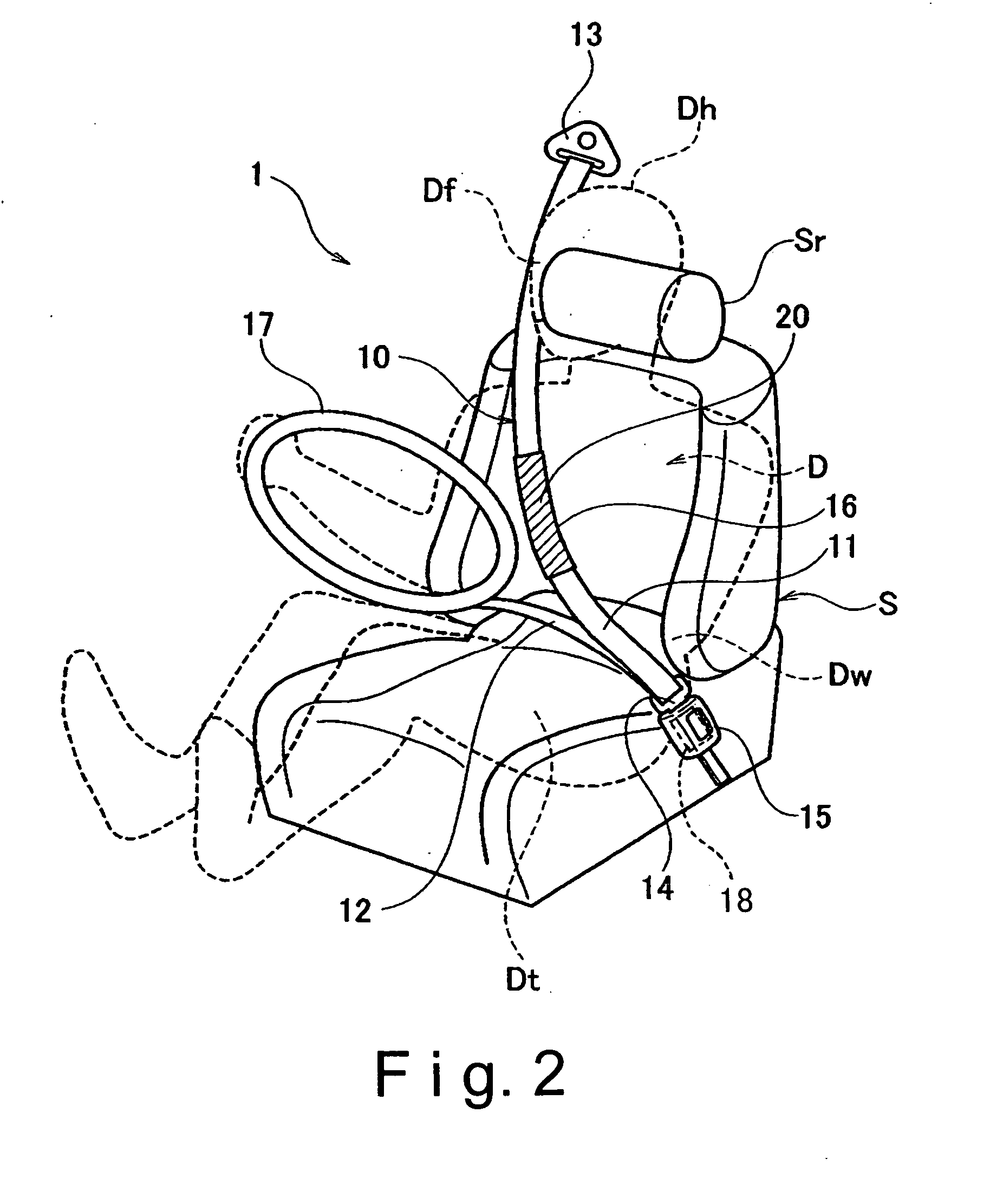Vehicle passenger restraint system
a passenger seat and seat belt technology, applied in the direction of vehicular safety arrangements, vehicle components, pedestrian/occupant safety arrangements, etc., can solve the problems of troublesome design of the storage space layout of the frontward airbag, the restraining force of the seat belt is usually inevitable large, and the design freedom of the steering wheel is reduced, and the storage space is large. , to achieve the effect of reducing the design freedom of the steering wheel, reducing the restraining force of the seat bel
- Summary
- Abstract
- Description
- Claims
- Application Information
AI Technical Summary
Benefits of technology
Problems solved by technology
Method used
Image
Examples
second embodiment
[0051] Referring now to FIG. 5, a vehicle passenger restraint system 101 in accordance with a second embodiment will now be explained. In view of the similarity between the first and second embodiments, the parts of the second embodiment that are identical to the parts of the first embodiment will be given the same reference numerals as the parts of the first embodiment. Moreover, the descriptions of the parts of the second embodiment that are identical to the parts of the first embodiment may be omitted for the sake of brevity.
[0052] The vehicle passenger restraint system 101 of the second embodiment is basically identical to the vehicle passenger restraint system 1 of the first embodiment except that an additional airbag 120 of the second embodiment is provided with a fluid discharge port 120a configured and arranged to adjust a resistance force (an impact absorbency) of the additional airbag 120.
[0053]FIG. 5 is a frontal perspective view of the vehicle passenger restraint syste...
third embodiment
[0058] Referring now to FIG. 6, a vehicle passenger restraint system 201 in accordance with a third embodiment will now be explained. In view of the similarity between the first and third embodiments, the parts of the third embodiment that are identical to the parts of the first embodiment will be given the same reference numerals as the parts of the first embodiment. Moreover, the descriptions of the parts of the third embodiment that are identical to the parts of the first embodiment may be omitted for the sake of brevity.
[0059] The vehicle passenger restraint system 201 of the third embodiment differs from the vehicle passenger restraint system 1 of the first embodiment in that the vehicle passenger restraint system 201 of the third embodiment further include a steering wheel airbag 221 (a frontward airbag) that is provided in the steering wheel 17 as well as an additional airbag 220.
[0060]FIG. 6 is a left side elevational view of the vehicle passenger restraint system 201 of t...
fourth embodiment
[0067] Referring now to FIGS. 7(a), 7(b) and 8, a vehicle passenger restraint system 301 in accordance with a fourth embodiment will now be explained. In view of the similarity between the third and fourth embodiments, the parts of the fourth embodiment that are identical to the parts of the third embodiment will be given the same reference numerals as the parts of the third embodiment. Moreover, the descriptions of the parts of the fourth embodiment that are identical to the parts of the third embodiment may be omitted for the sake of brevity.
[0068] The vehicle passenger restraint system 301 of the fourth embodiment differs from the vehicle passenger restraint system 201 of the third embodiment in that a steering wheel airbag 321 is configured and arranged to deploy only when an impact value indicative of an impact force is detected to be equal to or greater than a threshold value A.
[0069] FIGS. 7 (a) and 7 (b) are left side elevational views of the vehicle passenger restraint sy...
PUM
 Login to View More
Login to View More Abstract
Description
Claims
Application Information
 Login to View More
Login to View More - R&D
- Intellectual Property
- Life Sciences
- Materials
- Tech Scout
- Unparalleled Data Quality
- Higher Quality Content
- 60% Fewer Hallucinations
Browse by: Latest US Patents, China's latest patents, Technical Efficacy Thesaurus, Application Domain, Technology Topic, Popular Technical Reports.
© 2025 PatSnap. All rights reserved.Legal|Privacy policy|Modern Slavery Act Transparency Statement|Sitemap|About US| Contact US: help@patsnap.com



